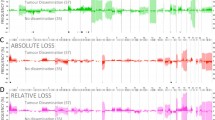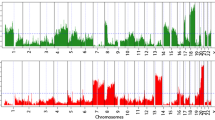Abstract
Loss of heterozygosity (LOH) for markers on X chromosome are associated with malignancy in endocrine tumors of the stomach and pancreas. The aim of this work is to investigate low-grade, well-differentiated endocrine carcinomas (WDEC) vs high-grade, poorly differentiated endocrine carcinomas (PDEC) of the gastroenteropancreatic (GEP) tract for common deletion regions on X chromosome. We performed a comparative allelotyping analysis with 24 highly polymorphic markers for the X chromosome in 12 WDECs and 5 PDECs. Overall, the LOH frequency in all informative loci investigated was 59% in primary and 61% in metastasis, with a significantly higher rate in PDECs than in WDECs (p<0.015 for primary and p<0.00005 for metastasis). In both WDECs and PDECs, the small Xq25 region as defined by DXS8059, DXS8098, and DXS8009 markers showed higher LOH rate as compared to the rest of the chromosome markers (p<0.04). In addition, LOH was very frequently elevated also in DXS294 and in DXS102 loci mapping the chromosomal region Xq26. In no instances differences were found between primary tumors and metastases. Methylation analysis revealed that Xq25 loss preferentially occurred on the inactive X chromosome, a feature in agreement with findings from other human cancers suggesting escape of tumor suppressor genes to X chromosome inactivation at this region. Overall, our data indicate that the two chromosomal regions, Xq25 and Xq26, may participate to the malignant progression of GEP endocrine carcinomas.

Similar content being viewed by others
References
Barghorn A, Komminoth P, Bachmann D, Rutimann K, Saremaslani P, Muletta-Feurer S, Perren A, Roth J, Heitz PU, Speel EJ (2001) Deletion at 3p25.3–p23 is frequently encountered in endocrine pancreatic tumours and is associated with metastatic progression. J Pathol 194:451–458
Beckmann MW, Picard F, An HX, van Roeyen CR, Dominik SI, Mosny DS, Schnurch HG, Bender HG, Niederacher D (1996) Clinical impact of detection of loss of heterozygosity of BRCA1 and BRCA2 markers in sporadic breast cancer. Br J Cancer 73:1220–1226
Brandau O, Schuster V, Weiss M, Hellebrand H, Fink FM, Kreczy A, Friedrich W, Strahm B, Niemeyer C, Belohradsky BH, Meindl A (1999) Epstein–Barr virus-negative boys with non-Hodgkin lymphoma are mutated in the SH2D1A gene, as are patients with X-linked lymphoproliferative disease (XLP). Hum Mol Genet 8:2407–2413
Chen YJ, Vortmeyer A, Zhuang Z, Gibril F, Jensen RT (2004) X-chromosome loss of heterozygosity frequently occurs in gastrinomas and is correlated with aggressive tumor growth. Cancer 100:1379–1387
Cheng PC, Gosewehr JA, Kim TM, Velicescu M, Wan M, Zheng J, Felix JC, Cofer KF, Luo P, Biela BH, Godorov G, Dubeau L (1996) Potential role of the inactivated X chromosome in ovarian epithelial tumor development. J Natl Cancer Inst 88:510–518
Choi C, Cho S, Horikawa I, Berchuck A, Wang N, Cedrone E, Jhung SW, Lee JB, Kerr J, Chenevix-Trench G, Kim S, Barrett JC, Koi M (1997) Loss of heterozygosity at chromosome segment Xq25–26.1 in advanced human ovarian carcinomas. Genes Chromosomes Cancer 20:234–242
Choi C, Kim MH, Juhng SW (1998) Loss of heterozygosity on chromosome XP22.2–p22.13 and Xq26.1–q27.1 in human breast carcinomas. J Korean Med Sci 13:311–316
Chung DC, Smith AP, Louis DN, Graeme-Cook F, Warshaw AL, Arnold A (1997) A novel pancreatic endocrine tumor suppressor gene locus on chromosome 3p with clinical prognostic implications. J Clin Invest 100:404–410
D'Adda T, Candidus S, Denk H, Bordi C, Hofler H (1999) Gastric neuroendocrine neoplasms: tumour clonality and malignancy-associated large X-chromosomal deletions. J Pathol 189:394–401
D'Adda T, Bottarelli L, Azzoni C, Pizzi S, Bongiovanni M, Papotti M, Pelosi G, Maisonneuve P, Antonetti T, Rindi G, Bordi C (2005) Malignancy-associated X chromosome allelic losses in foregut endocrine neoplasms: further evidence from lung tumors. Mod Path 18:795–805
Farnebo F, Teh BT, Dotzenrath C, Wassif WS, Svensson A, White I, Betz R, Goretzki P, Sandelin K, Farnebo LO, Larsson C (1997) Differential loss of heterozygosity in familial, sporadic, and uremic hyperparathyroidism. Hum Genet 99:342–349
Furlan D, Cerutti R, Uccella S, La Rosa S, Rigoli E, Genasetti A, Capella C (2004) Different molecular profiles characterize well-differentiated endocrine tumors and poorly differentiated endocrine carcinomas of the gastroenteropancreatic tract. Clin Cancer Res 10:947–957
Hedvat CV, Yao J, Sokolic RA, Nimer SD (2004) MEF is a potent activator of interleukin-8 expression in hematopoietic cells. J Biol Chem 279:6395–6400
Herman JG, Graff JR, Myohanen S, Nelkin BD, Baylin SB (1996) Methylation-specific PCR: a novel PCR assay for methylation status of CpG islands. Proc Natl Acad Sci U S A 93:9821–9826
House MG, Herman JG, Guo MZ, Hooker CM, Schulick RD, Lillemoe KD, Cameron JL, Hruban RH, Maitra A, Yeo CJ (2003) Aberrant hypermethylation of tumor suppressor genes in pancreatic endocrine neoplasms. Ann Surg 238:423–431
Jiang F, Richter J, Schraml P, Bubendorf L, Gasser T, Sauter G, Mihatsch MJ, Moch H (1998) Chromosomal imbalances in papillary renal cell carcinoma: genetic differences between histological subtypes. Am J Pathol 153:1467–1473
Jones FS, Jones PL (2000) The tenascin family of ECM glycoproteins: structure, function, and regulation during embryonic development and tissue remodelling. Dev Dyn 218:235–259
Kersemaekers AM, van de Vijver MJ, Kenter GG, Fleuren GJ (1999) Genetic alterations during the progression of squamous cell carcinomas of the uterine cervix. Genes Chromosomes Cancer 26:346–354
Kibel AS, Faith DA, Bova GS, Isaacs WB (2003) Xq27–28 deletions in prostate carcinoma. Genes Chromosomes Cancer 37:381–388
Kim H, Xu GL, Borczuk AC, Busch S, Filmus J, Capurro M, Brody JS, Lange J, D'Armiento JM, Rothman PB, Powell CA (2003) The heparan sulfate proteoglycan GPC3 is a potential lung tumor suppressor. Am J Respir Cell Mol Biol 29:694–701
Klein CB, Conway K, Wang XW, Bhamra RK, Lin XH, Cohen MD, Annab L, Barrett JC, Costa M (1991) Senescence of nickel-transformed cells by an X chromosome: possible epigenetic control. Science 251:796–799
Knudson AGJ (1971) Mutation and cancer: statistical study of retinoblastoma. Proc Natl Acad Sci U S A 68:820–823
Latour S, Veillette A (2003) Molecular and immunological basis of X-linked lymphoproliferative disease. Immunol Rev 192:212–214
Minamitani T, Ariga H, Matsumoto K (2002) Adhesive defect in extracellular matrix tenascin-X-null fibroblasts: a possible mechanism of tumor invasion. Biol Pharm Bull 25:1472–1475
Missiaglia E, Moore PS, Williamson J, Lemoine NR, Falconi M, Zamboni G, Scarpa A (2002) Sex chromosome anomalies in pancreatic endocrine tumors. Int J Cancer 98:532–538
Murphy-Ullrich JE (2001) The de-adhesive activity of matricellular proteins: is intermediate cell adhesion an adaptive state? J Clin Invest 107:785–790
Nikiforova MN, Nikiforov YE, Biddinger P, Gnepp DR, Grosembacher LA, Wajchenberg BL, Fagin JA, Cohen RM (1999) Frequent loss of heterozygosity at chromosome 3p14.2–3p21 in human pancreatic islet cell tumours. Clin Endocrinol 51:27–33
Piao Z, Malkhosyan SR (2002) Frequent loss Xq25 on the inactive X chromosome in primary breast carcinomas is associated with tumor grade and axillary lymph node metastasis. Genes Chromosomes Cancer 33:262–269
Pizzi S, D'Adda T, Azzoni C, Rindi G, Grigolato P, Pasquali C, Corleto VD, Delle Fave G, Bordi C (2002) Malignancy-associated allelic losses on the X-chromosome in foregut but not in midgut endocrine tumours. J Pathol 196:401–407
Pizzi S, Azzoni C, Bassi D, Bottarelli L, Milione M, Bordi C (2003) Genetic alterations in poorly differentiated endocrine carcinomas of the gastrointestinal tract. Cancer 98:1273–1282
Pizzi S, Azzoni C, Bottarelli L, Campanini N, D'Adda T, Pasquali C, Rossi G, Rindi G, Bordi C (2005) RASSF1A promoter methylation and 3p21.3 loss of heterozygosity are features of foregut, but not midgut and hindgut, malignant endocrine tumours. J Pathol 206:409–416
Russell AJ, Sibbald J, Haak H, Keith WN, McNicol AM (1999) Increasing genome instability in adrenocortical carcinoma progression with involvement of chromosomes 3, 9 and X at the adenoma stage. Br J Cancer 81:684–689
Sakakura C, Mori T, Sakabe T, Ariyama Y, Shinomiya T, Date K, Hagiwara A, Yamaguchi T, Takahashi T, Nakamura Y, Abe T, Inazawa J (1999) Gains, losses, and amplifications of genomic materials in primary gastric cancers analyzed by comparative genomic hybridization. Genes Chromosomes Cancer 24:299–305
Sandberg AA (1983) The X chromosome in human neoplasia, including sex chromatin and congenital conditions with X-chromosome anomalies. In: Sandberg AA (ed) Cytogenetics of the mammalian X chromosome. Alan R. Liss, New York pp 459–498
Seki Y, Suico MA, Uto A, Hisatsune A, Shuto T, Isohama Y, Kai H (2002) The ETS transcription factor MEF is a candidate tumor suppressor gene on the X chromosome. Cancer Res 62:6579–6586
Solcia E, Capella C, Klöppel G, Heitz PU, Sobin LH, Rosai J (2000) Endocrine tumours of the gastrointestinal tract. In: Solcia E, Klöppel G, Sobin LH (eds) Histological typing of endocrine tumours. Springer, Berlin Heidelberg New York pp 61–68
Talvensaari-Mattila A, Paakko P, Hoyhtya M, Blanco-Sequeiros G, Turpeenniemi-Hujanen T (1998) Matrix metalloproteinase-2 immunoreactive protein: a marker of aggressiveness in breast carcinoma. Cancer 83:1153–1162
Terracciano LM, Bernasconi B, Ruck P, Stallmach T, Briner J, Sauter G, Moch H, Vecchione R, Pollice L, Pettinato G, Gurtl B, Ratschek M, De Krijger R, Tornillo L, Bruder E (2003) Comparative genomic hybridization analysis of hepatoblastoma reveals high frequency of X-chromosome gains and similarities between epithelial and stromal components. Human Pathol 34:864–871
Thrash-Bingham CA, Salazar H, Greenberg RE, Tartof KD (1996) Loss of heterozygosity studies indicate that chromosome arm 1p harbors a tumor suppressor gene for renal oncocytomas. Genes Chromosomes Cancer 16:64–67
Wistuba II, Tang M, Maitra A, Alvarez H, Troncoso P, Pimentel F, Gazdar AF (2001) Genome-wide allelotyping analysis reveals multiple sites of allelic loss in gallbladder carcinoma. Cancer Res 61:3795–3800
Acknowledgements
We wish to thank Mrs. Emilia Corradini for her histological assistance and Dott. Nicoletta Campanini for immunohistochemistry.
Author information
Authors and Affiliations
Corresponding author
Additional information
This study was supported by grants from the Italian Association for Cancer Research (AIRC), Milan; the Italian Ministry for University, Scientific and Technological Research (MURST grant number 2003063877-001); and the Italian Ministry of Health (grant number ICS060.2/RF00-57).
Rights and permissions
About this article
Cite this article
Azzoni, C., Bottarelli, L., Pizzi, S. et al. Xq25 and Xq26 identify the common minimal deletion region in malignant gastroenteropancreatic endocrine carcinomas. Virchows Arch 448, 119–126 (2006). https://doi.org/10.1007/s00428-005-0058-4
Received:
Accepted:
Published:
Issue Date:
DOI: https://doi.org/10.1007/s00428-005-0058-4




